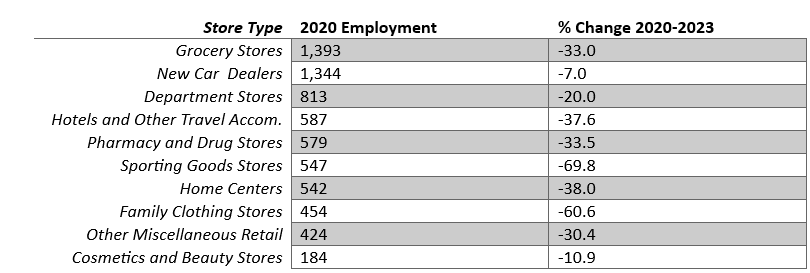The restrictions imposed on retail oriented businesses during the COVID pandemic had substantial effects on retail employment. At a local level, the effects were very much dependent upon the particular type of retail and the specific policies enacted at local and state levels.
As a case study, largely because of familiarity, we chose to look at the retail environment in Thousand Oaks, California between January 2020 and January 2023 using our BusinessCounts database at the census block level.
The city has two main shopping areas that reflect the original main streets prior to the development of the freeways – Thousand Oaks Boulevard/Hillcrest Drive (formerly US 101) and Moorpark Road (formerly California highway 23). At the west end of the retail area is the Oaks Mall, an upscale regional mall anchored by Nordstrom and JC Penney, and at the east end is the Thousand Oaks Auto Mall (one of the largest in southern California) and The Promenade.
Over a three year period, retail employment dropped by 25 percent, as restrictions were both severe and long lasting.

Looking at the main store types is an interesting study:

Only a few categories showed growth during the period – Drinking Places, Liquor Stores, Special Food Services and Catering, Hardware Stores, and Gasoline Stations.
On the decline side, both the sporting goods and family clothing categories suffered because of retail closures, while most others simply have fewer employees than before, as both self-checkout stands and curbside delivery have had a major effect on grocery and home center employment. Most of the large chains fared reasonably well since they were able to operate and publicize curbside pickup services, leaving the bulk of the closures to small, independent retailers.
New car dealers were minimally affected, largely because the City of Thousand Oaks declared new (but not used) dealers as “essential” and these businesses were never closed down. The city received much criticism for this decision, and it was noted that the new auto dealers contribute heavily to the municipal treasury.
The maps below show the two major shopping areas.
The relatively unscathed Thousand Oaks Auto Mall is surrounded by areas of substantial decline, both in the strip centers along Thousand Oaks Boulevard and at the upscale Promenade shopping center.

In the second, the lack of decline at the Thousand Oaks Marketplace is notable. Most of the strip centers along Moorpark Road, and The Oaks Mall itself, suffered from retail closures and layoffs. Why no decline at the one center? It had been in a state of decline for two decades and is now largely a discount oriented shopping center.



Recent Comments